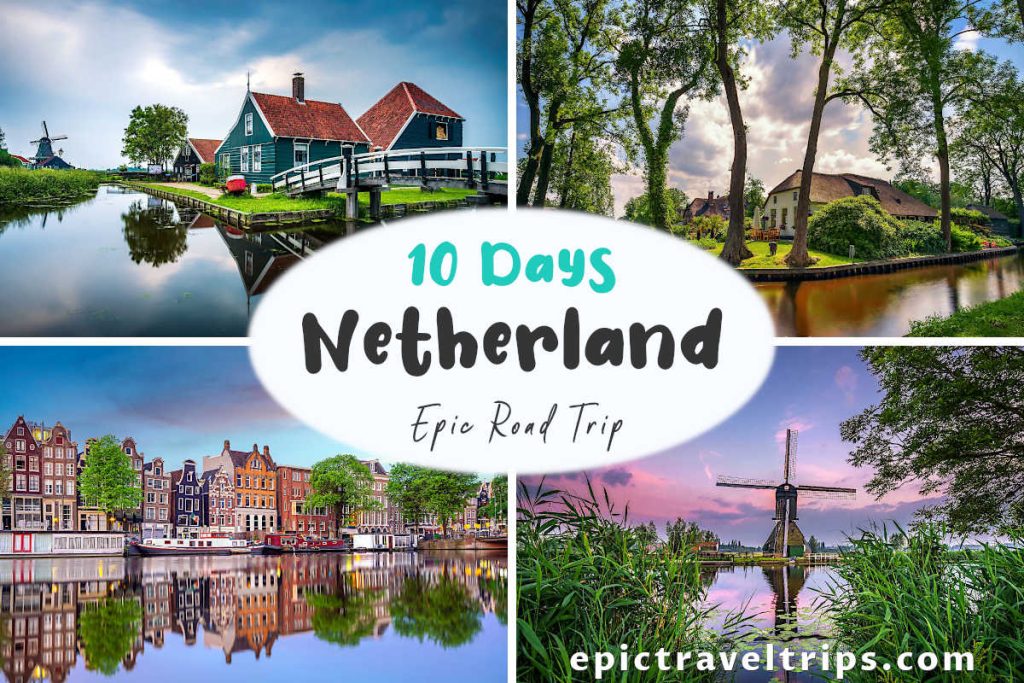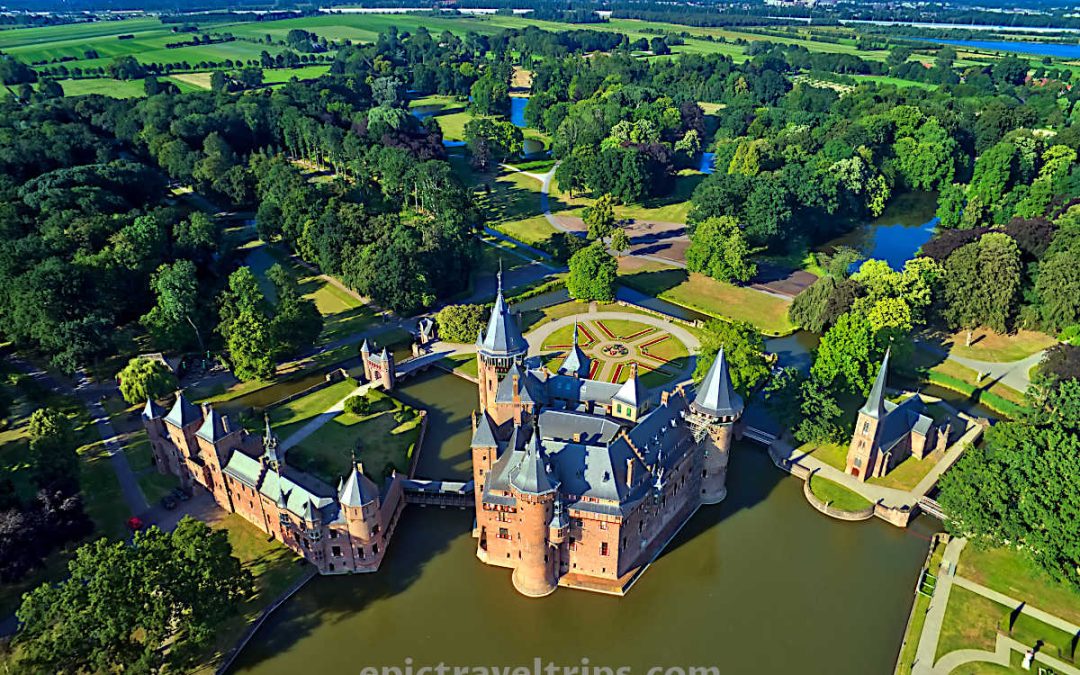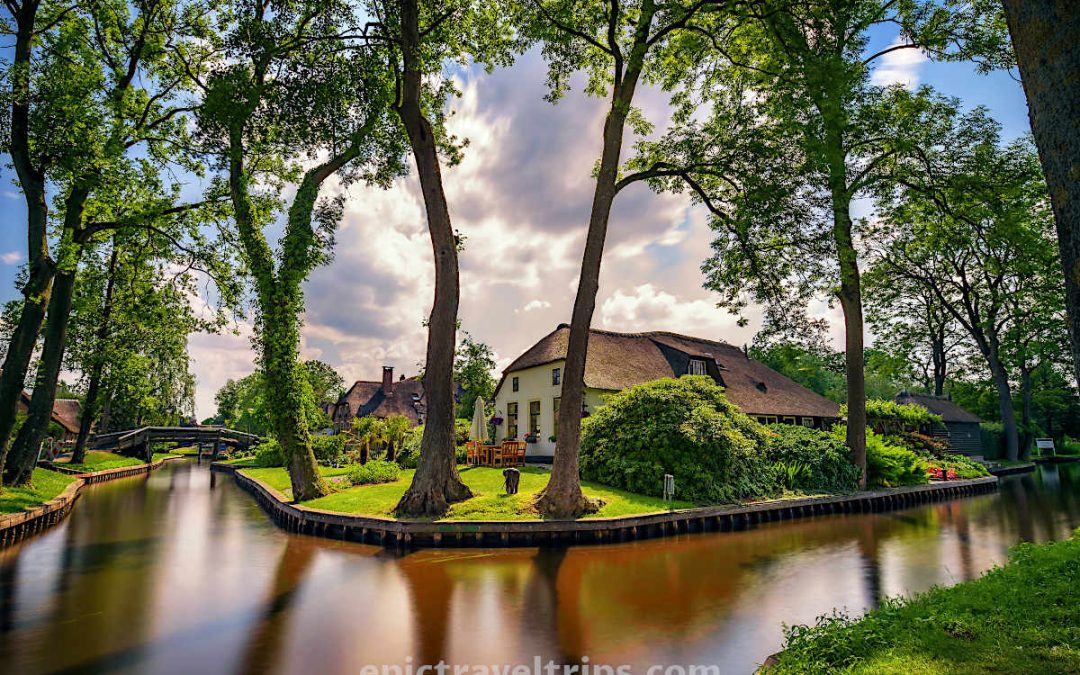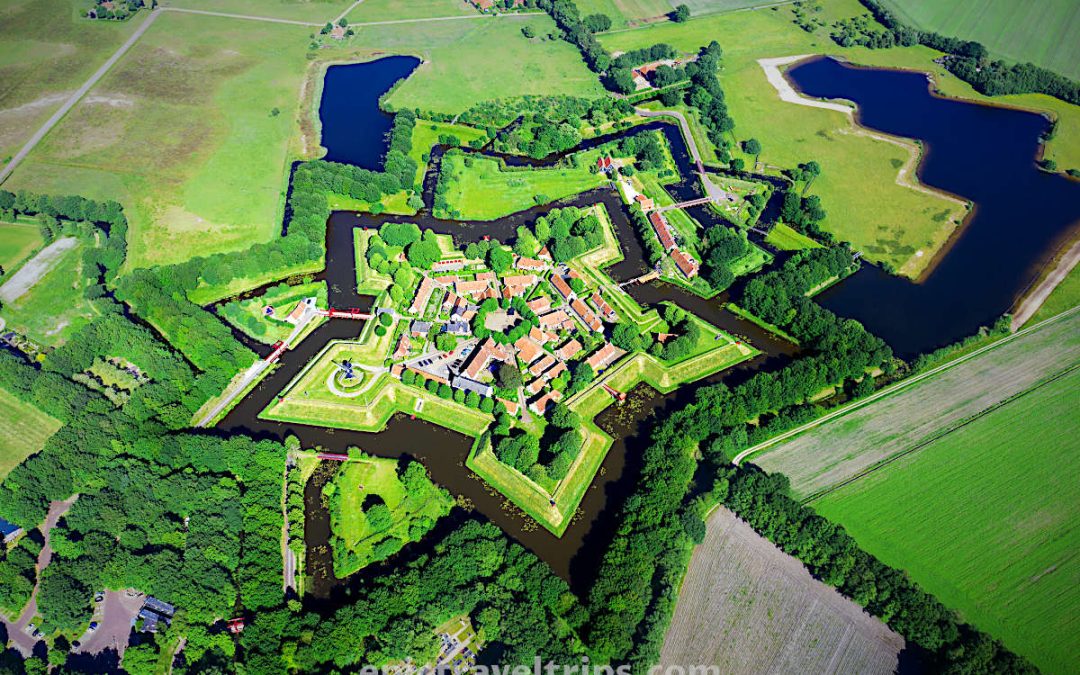- What Is
- What To See
- Kinderdijk vs Zaanse Schans
- Where is located?
- How To Reach?
- How Long Does It Take?
- Where To Park?
- How Much Is The Entrance Fee?
- Opening Hours & Season
- When Is The Best Time To Visit?
- Where To Eat?
- Where To Stay?
- What Is Nearby?
- Kinderdijk – Our Impressions
What is Kinderdijk?
Kinderdijk Windmills are part of the Dutch water management system to pump water out of the low-lying polders and prevent flooding.
Why do they have to do that? One-third of The Netherlands is below sea level, and the country is very densely populated. Therefore, the Dutch must constantly pump the water to keep their feet dry.
Kinderdijk is two meters (6.56 ft) below sea level, so hopefully, you understand why water management is essential at Kinderdijk and in most of The Netherlands in general.
Kinderdijk Windmills were part of our The Netherlands: Epic 10 Days for Perfect Itinerary Road Trip with Maps. So, we drew a Google Map of our trip and make your navigation easier.

What To See In Kinderdijk
The shuttle bus left us in front of the Ticket & Info Office building. The office is at the beginning of the bicycle and walking path to the windmills. The day was scorchingly hot. Besides, there weren’t trees or shade areas on the walking path. So be sure you have a hat, sun umbrella (if you prefer), sunglasses, sun protection creams, water, etc.
In the ticket/info office, we got some extra info about Kinderdijk and the code for the audio guide App that we could listen to while moving around.
Access to the Kinderdijk Windmills is free of charge as they are in a public area. Yet, if you buy a ticket, you can go inside two windmills, visit a pumping station, and watch a short movie about Kinderdijk.

We decided to walk to the two windmills first. Next, if we had free time visit the pumping station and watch a movie.
In front of us was a beautiful scenery of canals and windmills in the distance as one imagined the Dutch countryside.
1 – Museum Windmill Nederwaard (Museummolen Nederwaard)
Windmill Nederwaard is one of the 19 windmills located in Kinderdijk. The year 1738 was its built year, more than one hundred years after the Windmill Blokweer, which is also accessible for an inside visit. For many generations, it was home to one family. Nowadays, it serves as a museum in the open. Visitors can learn about the history of windmills and their role in keeping the low-lying land of Alblasserwaard dry.
Inside the windmill, we could see how the mechanism transferred the wind energy into the pump work. In addition, the living conditions for the family living inside.
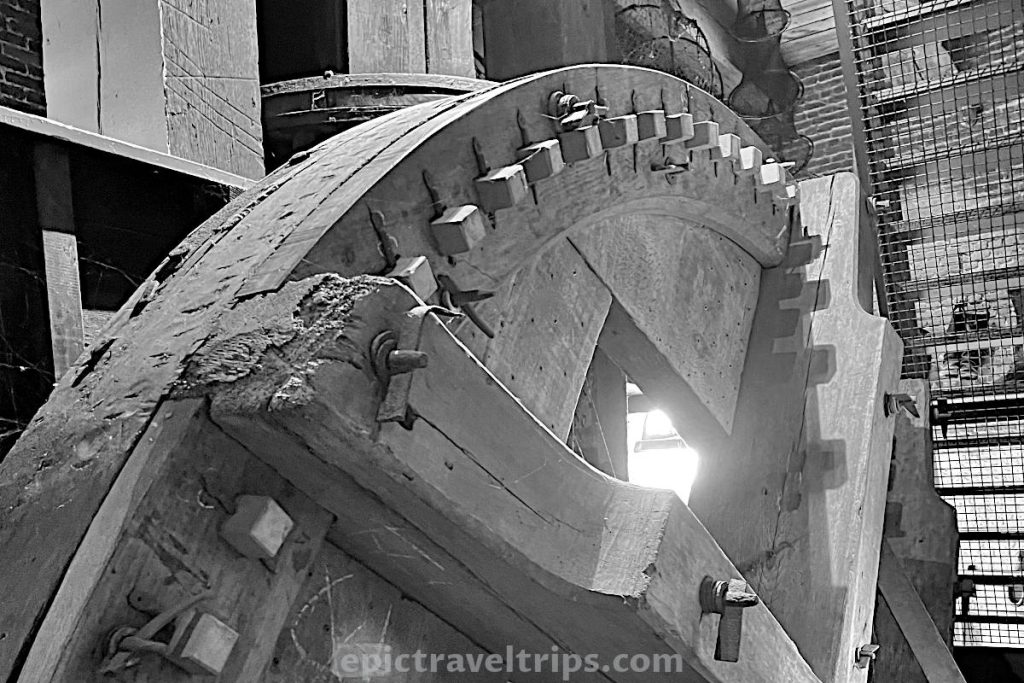
Outside we could see the whole mechanism for rotating the roof around the vertical axis. So the miller would align the windmill sails with the wind direction. As a result, the power of the wind transfers into water pumping work to the greatest extent of efficiency.

2 – Museum Windmill Blokweer (Museummolen Blokweer)
The year 1630 was the building year of Windmill Blokweer and had been restored many times since then. It is the oldest windmill among the Kinderdijk windmills. Its unique design is very different and smaller than the other Kinderdijk windmills. The base is in the shape of a cut-off pyramid at the top. On top is a cube-shaped body with a black cap. The predominant building material was timber.
On the other hand, Nederwaard windmills have a higher base in the shape of a cut-off cone at the top with a small thatch cap with windows on the top and no cube-shaped body between them. The building material was tiny bricks, more modern for that time.
The museum mill offers a glimpse into what life was like in the 1950s.

3 – Wisboom Pumping Station (Wisboomgemaal)
1868 was the building year of the Wisboom Pumping Station (Wisboomgemaal in Dutch). Initially, the steam engine powered the station, but electric power replaced it in 1924. Visitors can enter the engine room with their tickets.
4 – Why Do Windmills Turn Counterclockwise?
The millers follow the same rule as the sailors on the sailship.
Therefore the miller would climb up the framework and use a left hand to hold on. At the same time, the right-hand works on sail-cloth (reef the sail, furl them up, take them in, or set them). Since the miller uses the right hand, the sail & stock needs to be on the right side and the framework on the left-hand side. Thus the sail needs to rotate counterclockwise.
We start to think of the millers as sailors on the sailboat that never leaves the port. Although, never say never. Sometimes, the necessity could move windmills to other locations thought.
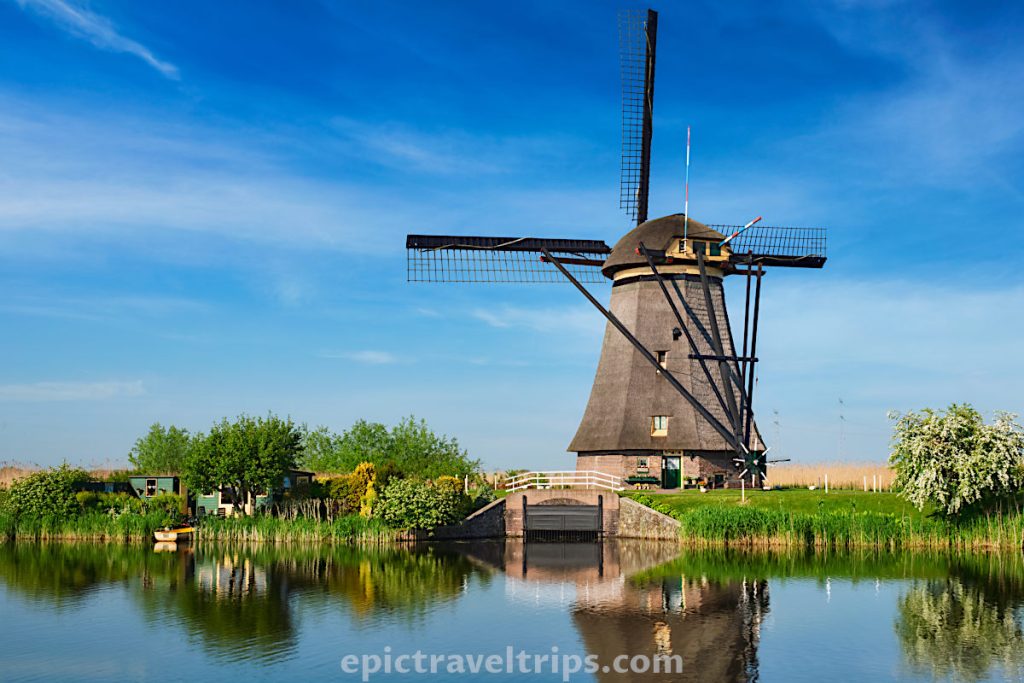
5 – Tradition In Windmills – Windmillers Signals
Windmills are visible from a distance, and especially noticeable is the sail position when stopped. Depending on the angle at which sail standstills means a different signal. Let’s decipher these signals.

Short Rest – A short rest is when one pair of sails is in the vertical, and the other pair is in the horizontal position. A short rest is usually for a day or two and often near Sunday when the millers were not allowed to work.
Long Rest – A long rest is when sails are at 45 degrees angle and make an X cross (Andrews cross). A long rest is most likely in the summertime when there is not much rain, so the windmills don’t need to work much.
Joy – A joy signal is when the upper sail is stopped just before reaching the highest (vertical) position. The “joy” occasions were birthdays, a baby was born, or a wedding coming out.
Mourning – A mourning signal is when the upper sail has passed the highest (vertical) position. The “mourning” occasions were when somebody was sick or had died.
Resistance members used windmills’ signaling systems during WWII to signal allies pilots.
6 – Film in Secondary pumping station (De Fabriek)
De Fabriek is the secondary pumping station after the Wisboom Pumping Station (Wisboomgemaal in Dutch). It features a multiscreen film that takes visitors on a quick journey through the history of Kinderdijk. Unfortunately, we did not have time to watch the movie, so one more reason to return one day.
7 – Audio Tours In Kinderdijk Official App
Audio Tours In Kinderdijk Official App is a good idea but needs a lot of user-friendly experience improvements in reality. For example, after downloading the app, there is no QR code to scan from your ticket and start using the audio guide. Instead, you must ask the tourist office lady to give you some “secret” code to type in and start using the app.
We strongly believe that programmers will solve these obstacles shortly.

Kinderdijk vs Zaanse Schans Windmills
The first windmills in the Netherlands appeared in the 12th century. The peak was in the 19th century. There were around nine thousand windmills all over the country. The windmills have different functions. Here we will focus on windmills between Kinderdijk and Zaanse Schans.
Kinderdijk and Zaanse Schans Windmills use wind energy to transfer into work. Here is where the similarities end and begin the difference in functionality.
Kinderdijk Windmills
Kinderdijk windmills use wind energy to transfer with beams, shafts, and gears into a pump device with a scoop wheel at the end. The scoop wheel pushes the water under the mill from the lower-level polders into the higher-level basin. The network of windmills and canals creates the whole system for water management and lifts the water in stages.
The polder water from the lowest level pumps by lower mills into the lower basin (ring canal or ring dyke), and the middle mills further pump up the water into an intermediate basin. Finally, upper mills pump the water from the intermediate basin into waterways, rivers, or directly into the sea.

To summarise the whole system in simple terms. The challenge was to drain the lake.
- The first stage was to build the ring dyke or ring canal around the lake.
- The second phase was to build several windmills that pumped water from the lake into the canal.
- As the work progressed, the water level was low that the scoop wheels couldn’t pump it anymore.
- There was a need to build a second set of windmills to pump the water into an intermediate basin or another ring of canals.
- The canal rings creation & windmill sets construction repeat until the deepest lake’s levels drain out.
Archimedean screw replaced old scoop wheels due to more efficiency. The modernized windmills pumped the water much higher than the scoop height of older windmills. This invention made it possible to drain much deeper lakes without creating a ring of dykes around the lake and lifting the water in stages.

Zaanse Schans Windmills
On the other hand, we look at Zaanse Schans Windmills as an industrial park and each windmill being a factory. Corn mills ground the grain. Sawmills sawed the wood, other industrial mills pressed and made paper (paper mills), oil mills produced oil, and many others.
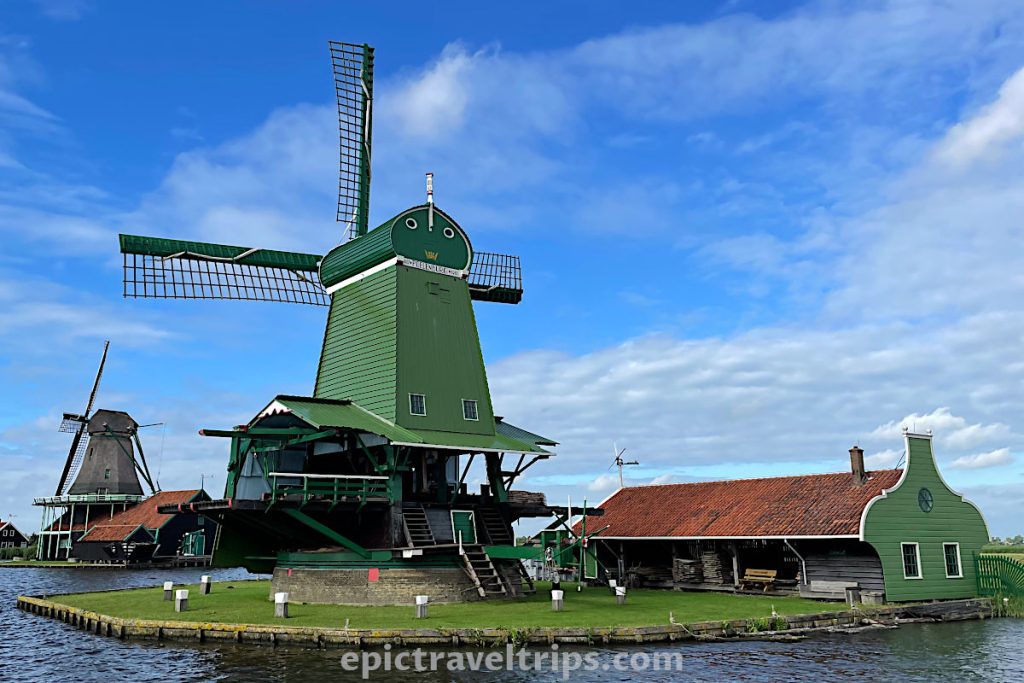
Where Is Kinderdijk Located?
The Kinderdijk Windmills are a group of 19 monumental windmills in the Alblasserwaard polder in South Holland province, Netherlands. It is a suburb of Rotterdam 25 km (15.5 mi) and half an hour’s drive from the city center.
Kinderdijk Windmills were part of our The Netherlands: Epic 10 Days for Perfect Itinerary Road Trip with Maps. So, we drew a Google Map of our trip and make your navigation easier.
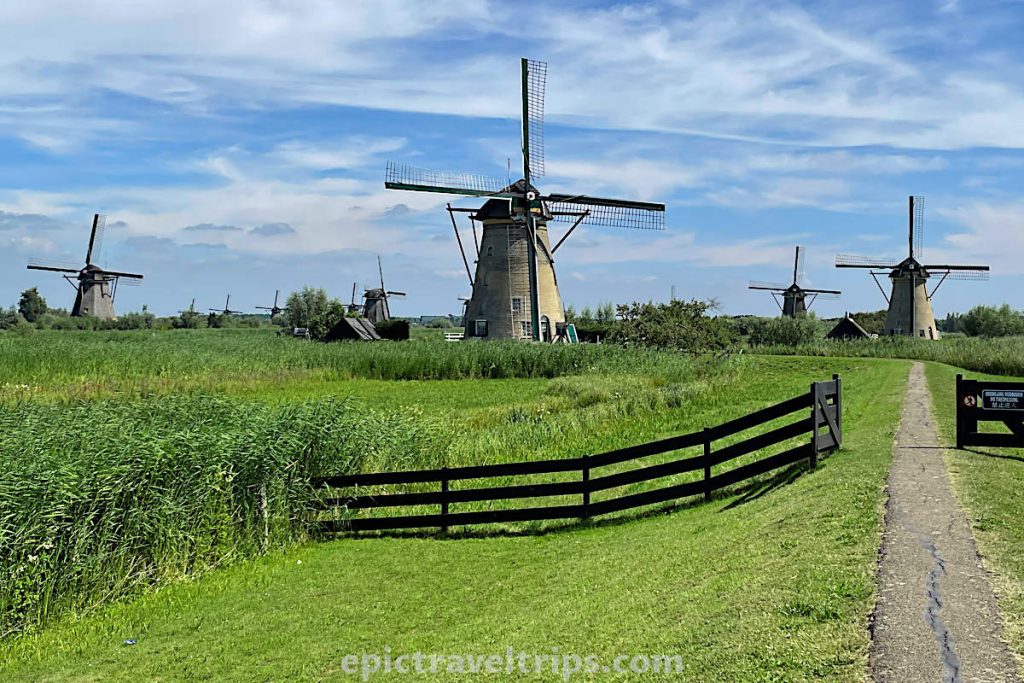
How To Reach Kinderdijk?
By car: We learned that we shouldn’t drive directly to the Kinderdijk entrance due to the limited parking space number. It is better to park at the address (Marineweg 3, Alblasserdam) and take the shuttle bus to the tour entrance.
In addition, please note that in The Netherlands, there are ecological driving rules with a restricted speed limit. The daytime (06:00-19:00 h) speed limit has been restricted to 100 km/h (62 mph), while the general speed limit on motorways is 130 km/h (80 mph).
Here are few practical info about distances, time travel, and roads:
- Rotterdam – Kinderdijk, 25 km (15.50 mi), 26 minutes drive, highways A16, and A15
- Eindhoven – Kinderdijk, 106 km (65.87 mi), 1h 10 minutes drive, highways A2, and A15
- Amsterdam – Kinderdijk, 95 km (59,00 mi), 1h 10 minutes drive, highways A2, A27, and A15
By water taxi: The best option is to take Line 21 from Erasmus Bridge directly to Kinderdijk. It takes between 30-40 minutes one way. Other options need transfer and additional payments so they are not convenient.
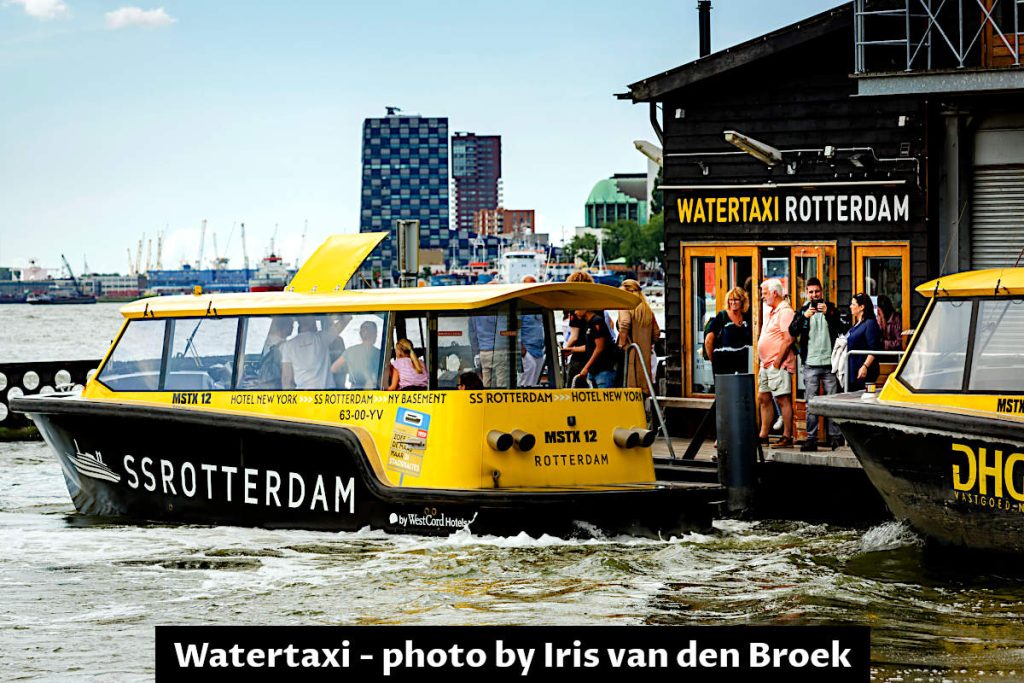
By bus:
Rotterdam – Kinderdijk
From Rotterdam Center (for example Blaak station) take Metro lines A, B, or C to the station Kralingse Zoom (east direction). Switch to bus line 489 in the direction of the Nieuw-Lekkerland exit at Kinderdijk, Molenkade station. A bus runs every half an hour every day.
By bike:
If you park the car at the parking lot (address: Marineweg 3, Alblasserdam) and you do not want to take a shuttle bus to Kinderdijk Windmills. You can rent a bike from Alblasserdam Tourist Office just a two-minute walk (address: Zuiderstek 22, Alblasserdam). From there you need to bike 5.2 km (3.23 mi) to Kinderdijk Windmills.
How Long Does It Take Kinderdijk Tour?
The Kinderdijk Windmills visit is half a day tour which means 3-4 hours to visit two museums, walk around, visit Wisboom pumping station, and watch a multiscreen film at De Fabrik. Of course, you can spend more or less time depending on personal preferences, interests, engagement, and available time.
We combined our visit to Kinderdijk with a visit to De Haar Castle: An Extravagant and Fairytale Vision of the Medieval near Utrecht.
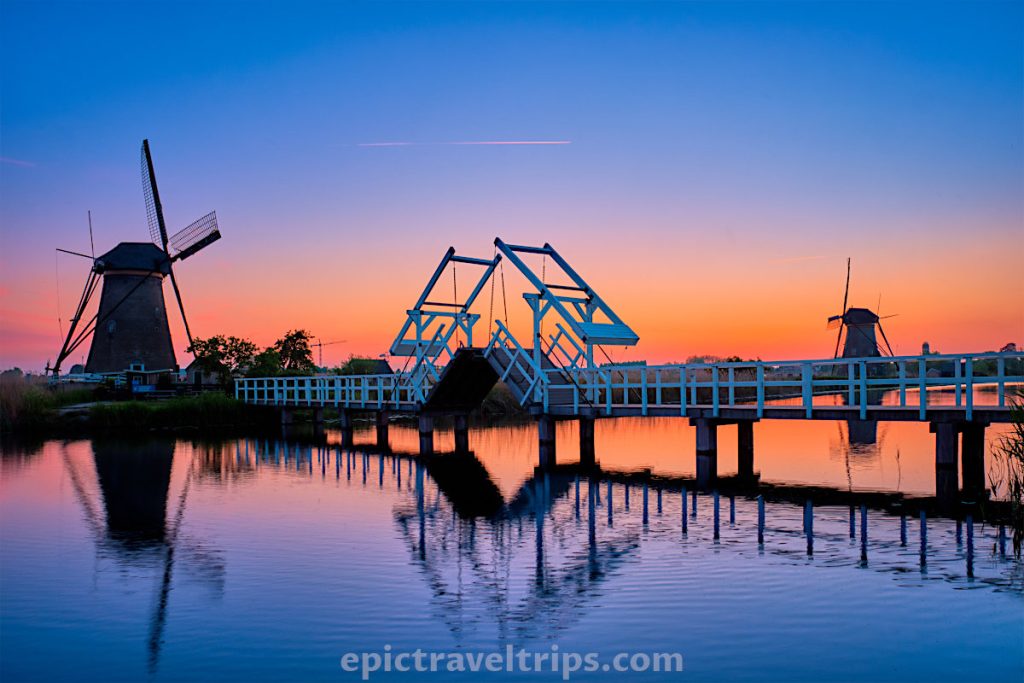
Where To Park For Kinderdijk Tour?
There is a limited number of parking spots near the Kinderdijk. The better option (if you drive a car) is to park at Marineweg 3, Alblasserdam, and take a shuttle bus from the parking to the Kinderdijk info center. The shuttle bus takes less than 10 minutes to Kinderdijk. You can purchase parking tickets and entrance tickets to the Kinderdijk museums at the booth in the parking lot. Another option is Park & Ride and visit the windmills by bicycle.
When we finished our visit to Kinderdjik, the shuttle bus brought us back to the parking lot.
Address: Marineweg 3, Alblasserdam
Capacity: around 200
Headroom: N/A
Season: March – October
Opening hours: 09:00 – 18:00
Rates: €7.50 per car
If you click this link and make a purchase, we earn a commission at no additional cost to you.

How Much Is The Entrance Fee?
You can enter for free, but if you want to visit two windmills museums inside, enter the pumping station, board the boat tour, watch a movie about Kinderdijk, and get access to the audio guide, then the entrance ticket is € 16,00 per person.
Opening Hours & Season
Kinderdijk is open nearly all year round. So there are no opening hours per se. However, the tourist office, parking, and museum have their opening hours. If we remember correctly, opening hours are between 09:00 – 18:00.
When Is The Best Time To Visit Kinderdijk?
Kinderdijk is open almost the whole year. Therefore each season has its own charm.
The tourist season is between April and October. However, the summer months of June, July, and August color the place in the most attractive shades so we can enjoy the best and have the desire to come back over and over again.
Most Dutch families have a vacation during the Dutch summer school holiday (mid-July to the end of August). So, consider this as a peak season.
We visited Kinderdijk in mid-July, and it wasn’t that overcrowded because the day was scorching. Please, you shouldn’t forget to bring sun protection (hats, sunglasses, sun protection creams, water, sun umbrellas, etc.)

Where To Eat?
After we walked the tour and returned, we stopped by the café near the Tourist Info Center for a quick break and refreshment while waiting for the shuttle bus to arrive and take us back to the parking lot. So we can continue our journey by visiting Rotterdam.
Where To Stay?
We stayed at Novotel Rotterdam Brainpark, a short distance from the subway station and not too far from the highway since we arrived by car. The room was tidy, with a big king bed and a nice view over the Rotterdam. The hotel reception was smooth services. To exit the parking, you must ask for a parking card for the gate reader. We skipped the offer for breakfast since it was too expensive. All in all, we were satisfied with the location, room, service, etc.
If you click this link and make a purchase, we earn a commission at no additional cost to you.

What Is Nearby Kinderdijk?
Rotterdam
Rotterdam is the second-largest city in the Netherlands and the biggest seaport in Europe. The city was raised like a Felix from the ashes after being almost completely demolished in WWII.

De Haar Castle (Kasteel de Haar)
De Haar Castle is the largest castle in the Netherlands, located just outside Utrecht and one hour’s drive north of Kinderdijk (68 km, 42 mi.). The castle was rebuilt in the 19th century and its walls hide extravagant history and flamboyant lifestyle of the castle’s owners, especially in the 1950s. It was our previous stop on our road trip before arriving at Kinderdijk.

Zaanse Schans Windmills
Zaanse Schans Windmills are not so close to the Kinderdijk, but since both locations are about windmills, it is worth mentioning and recommending this unique and fabulous attraction.

Kinderdijk – Our Impressions
We knew that The Netherlands is a country of windmills, but we assumed that grinding wheat or corn into flour was the only windmills usage. A visit to Zaanse Schans Windmills enlightened us with new and valuable knowledge.
However, Kinderdijk’s visit was a very different and educational experience about windmills, work, and life within and around them. After visiting Kinderdijk Windmills, we learned further about polder drainage mills and water management systems developed by windmills.
Finally, we remind ourselves that on a scorching day, it is wise to have sun protection since there are no trees to make shade on the walking path.
We made a Google Map so you can follow our The Netherlands 10 Days Epic Road Trip.
We wish you an epic trip!
